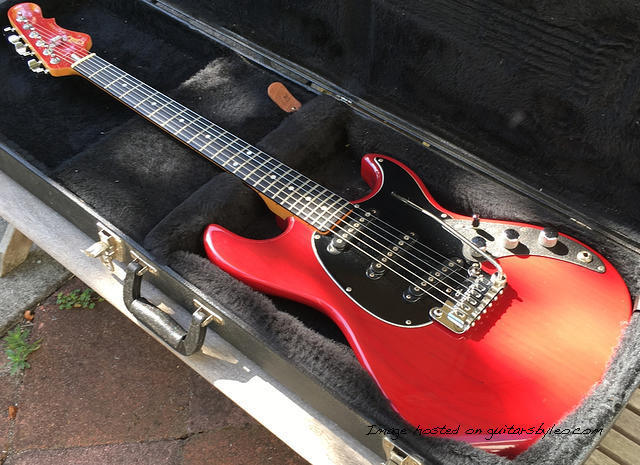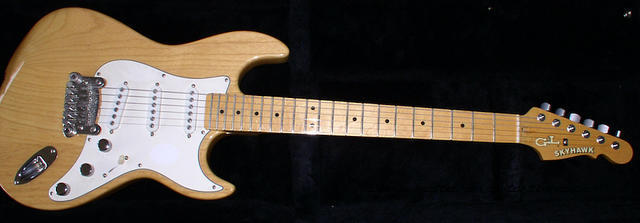My G&L odyssey truly began in 2007 when I bought a Custom Creations Comanche Studio 6; then 3 years later, an ASAT Jr. I restrained myself for a while, trying to keep a low budget and peace in the house, but in 2014 I bought my first Leo-era G&L: a second-generation 1988 Skyhawk with maple body, rosewood fretboard, and sickle headstock, in purple (!). When I picked it up from a local tech after some minor work, he remarked, “This is a great guitar.” I had to agree: it played effortlessly all over the thin, narrow neck (nut less than usual 1-5/8), the single-coil tones were all I ever wanted but couldn’t get from my Stratocaster for almost 30 years (sold after the Comanche arrived; no regrets), and the tone of the maple body got me closer to classic Jerry Garcia tones. This remains one of my favorite G&Ls to play. Did I mention that it’s purple?
Photo op:
This opened my eyes to Leo-era goodness. Soon enough, a maple-bodied ’88 ASAT arrived as a poor man’s Broadcaster. But the Skyhawks continued to interest me (as I pored over every entry on Greg Gagliano’s ggjaguar website), and I wanted a first-generation one. Found a 1986 in swamp ash with the ebony board I desired. This was a perfectly fine guitar with great tones and playability, yet I usually grabbed The Purple One.
Photo op: (“Trouble ahead/lady in red!”)

The trouble was that I regularly scoured the web, Reverb, and Guitar Center for used G&Ls, and gradually added several unique models…. One day, Dave’s Music Shop listed a minty, gorgeous blonde over ash Skyhawk Signature; I forwarded the link to a friend, who replied, “What are you waiting for?” My answer: I owned two Skyhawks already; if I bought a Signature, I wanted one in cherryburst. The blonde sold in 2 days. But soon after, Dave’s listed a minty 1990 Skyhawk Signature in cherryburst over ash with a maple fretboard. I sent the link to my buddy and wrote, “Well, that worked out nicely!”
This swamp ash body is quite lightweight (3.4 lbs, per pencil mark in neck pocket), which I think is a trend around that time (e.g., ASAT Classic Signature top bound); G&L must have obtained a good batch of swamp ash, the likes of which are unobtainium these days. (On the other hand, the swamp ash Comanche VI from Greg G’s collection via Mr. Roundel is noticeably heavier, despite being from 1990.) The maple fretboard has a decidedly different feel than the rosewood of The Purple One, but it’s a good feel: the frets are quite low (common around this time, in my limited experience), the action is low and slinky, and the overall tone of the guitar is clear, spanky, and articulate. Maybe this guitar came from a collection or old dealer stock: you can see the different color from the “Made in USA” sticker on the protective plastic that remained on the pickguard for a long time, and the back of the neck is lighter behind the first fret than up the neck, from UV exposure or a hanger?
Photo op (from dealer's listing):

Six months later, Guitar Center listed a late model Skyhawk with the fine tuner bridge (second version), and that feature plus the going price was enough for me to buy it. I picked it up from a GC store when we had a winery gig nearby, and showed it to my guitar partner…. Mint condition, swamp ash, maple fretboard, fine tuner bridge but nonlocking nut, and the neck that belongs to a “Signature” Skyhawk but the body had no signature! Turns out that the heavy, three-piece body was stamped 1988, but the neck was stamped one week after Leo’s death in 1991. My conjectures are perhaps an influx of orders after Leo’s passing, and/or Dale Hyatt foreseeing the future and trying to build as many guitars as possible, maybe even from parts sitting around such as this pre-“Signature” body (would have been mated to a sickle headstock neck) that maybe was set aside as too heavy? Can anyone shed a light on G&L history at this time?
Anyway, this guitar had a wider, 1-3/4 inch nut and much taller frets than I had seen on a G&L. One of my acoustics has that nut width, so I’m familiar with it. But, after a few minutes playing this Skyhawk, the width was forgotten—the strings had so much snap, such great attack and tone, and the playability up and down the fretboard was simply outstanding! What a guitar!! [Edit: I wonder if the pronounced "snap" of these strings derives from tension in the fine-tuning adjustment screw springs? I set it up with those screws tightened halfway down, which lowers each string's L-shaped rocker "baseplate"... No other G&L of a couple dozen that I have played has this "snap."] A little later, I loaned it to my guitar partner/bandmate (see above), whom I had already corrupted with an ASAT Classic Signature, his first G&L after an ’80s Fender Japan Stratocaster, a late ’80s Gibson 335, and two PRS. He returned the Skyhawk a few weeks later, saying, “This is too good to keep away from you this long.” I responded, “If you like it and want it, I’d happily sell it to you.” We agreed, and he’s loved it since. Kicked his Fender to the curb.
Photo op:

Soon after, because I “suddenly” owned around a dozen G&Ls, I thought I should further reduce the redundancies (ha!) of four Skyhawks despite their different wood combos, so I sold the red Skyhawk to a happy buyer. Now it was only The Purple One and the Signature.
I’ve been tempted by many Skyhawks before and since, some in great condition, some with unfortunate molestations, and some with head-scratching prices… I did well for a long time, but in early 2020 (pre COVID), a first-generation Skyhawk with a mahogany body caught my eye. I love the warm tone of mahogany, in acoustics and in G&Ls (e.g., ASAT Jr., ASAT Super), and the mahogany S-500s and F-100s always tempt me (especially in three-tone sunburst). A closer look at photos showed a sanded neck (hmm, unappealing) and some finish chips on the bottom (use a guitar stand!), but a quite low serial number for a Skyhawk. I thought it could be an early Skyhawk with a Nighthawk body; that, the mahogany, and the price were enough for me to click the button. Sure enough, the body date is mid-1983 while the neck is January 1984, when the name change occurred. This guitar’s tone is quite pleasing and distinct from the others—the mahogany adds warmth and smooths the trebles beautifully. The maple neck is comfortable, and the sanded finish is barely discernible to my touch. Three-tone sunburst and matching headstock add to the beauty, especially after I cleaned away the accumulated grime.
Photo op:

So, “That’s how it stands today/You decide if he was wise.” Three Skyhawks, each unique in wood combos, tones, but all excellent, S-type guitars. I can’t recommend this model enough to those who like S-type guitars but crave more tone, which these pickups deliver. Plus: PTB circuit!
For another view: I did buy a Fender Robert Cray Stratocaster (made in Mexico) recently, upon repeated urging from the reliable ToneQuest Report, and it does a far better Strat than my old ’79. Robert Cray had a say in the pickup design for this guitar, and they are said to be among the best Stratocaster pickups that the F company makes. They do sound good; or as another music partner said, “Did you replace the pickups in that guitar?” I’ve been using it for a weekly outdoor gig in adverse weather. I still prefer Skyhawk pickups for their wider frequency spectrum. And: I’ve only ever played three or four modern S-500s, U.S. and Tribute, which didn’t capture my ear as much. I haven’t explored the Leo-era S-500 yet…